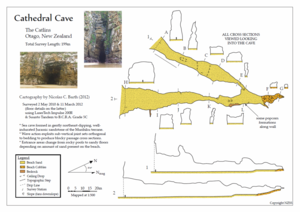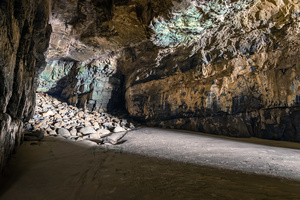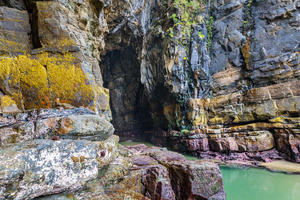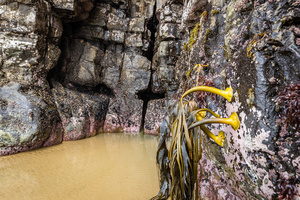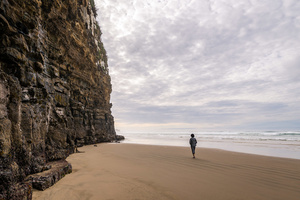The Caves
Geological History of Cathedral Caves, Catlins
Over tens of thousands of years, crashing waves have gouged out the caves in a cliff of Jurassic sandstone about 160 million years old. The two caves, which have separate entrances 40 metres apart, eventually became joined at the back during the long process of forming them. Because the transport of beach sand is affected by storms and currents, cave entrances may have rocky pools or sandy floors, depending on the sea flow.
In contrast to limestone caves, which are formed from chemical action as well as the physical process of water pounding on the rock, the Cathedral Caves were created by waves eroding the harder sandstone. Near-vertical fractures in the sandstone provided weak points for the wave energy to slowly dismantle the sandstone faces. In time, the overhanging rocks collapsed, creating caves with cathedral-like formations.
European naming of Cathedral Caves, Catlins
Known to Maori for centuries, Cathedral Caves received their name from a leading Dunedin physician, ethnologist and collector, Dr T.M. Hocken and his companions raised their voices and reported a 'reverberating' sound.
Natural History and Unique Wildlife
The Catlins region is renowned for its temperate rainforest, and the walk to Waipati Beach passes through a good example of this forest type. Podocarp trees of ancient lineage are among the largest – rimu, miro and totara. Flowering trees include the red-flowering southern rata and the prolific kamahi, which has creamy flower spikes. Tree ferns, ground ferns, mosses and supplejack vines add complexity to the forest. There are tracts of silver beech/tawhai in the vicinity – another canopy species along with the podocarps. Relatively high local rainfall is what fuels it all.
Birdlife to spot in Cathedral Caves Rainforest
In the forest, the birdlife includes the melodic bellbird/korimako and tui, the chattering tomtit/miromiro and fantail/pīwakawaka, and the grey warbler/riroriro, whose haunting warble carries a long way. The New Zealand pigeon/kererū our only native pigeon species lives here too.
Beach Wildlife at Cathedral Caves
Down at the beach, you may find the variable (black) oystercatcher/tōrea pango, red-billed gull/tarapuka and black-backed gull/karoro. New Zealand sea lions/pakake and fur seals/kekeno and protected native species like the birds, may appear on the beach. Department of Conservation recommends keeping at least 10 metres away from them, so as not to disturb wildlife. Looking seawards, you might catch sight of albatrosses, including Buller’s albatross and the giant royal albatross, patrolling inshore for food. The secluded estuary at the far end of the beach is in a largely natural condition, covering more than 50 ha. Within the caves, you can spot a wide range of native New Zealand shellfish and sea life on the cave walls. You’ll see groups of green-lipped mussel/kuku waiting for the tide to come back in. Please don’t pick any shellfish/kaimoana as we are trying to preserve our sea life and there are strict restrictions on collecting shellfish in New Zealand.

